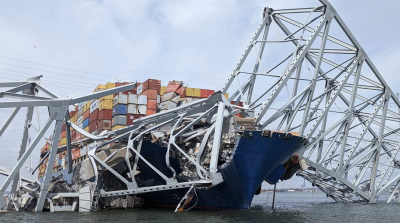The sinking of the El Faro and loss of 33 lives was a tragedy of incalculable proportion. Important questions are being asked about the casualty and will be discussed for years to come, but this is about how history repeats itself.
Any ship can be victimized by Mother Nature and the oceans. The last ship billed as “unsinkable” was the Titanic. We know how that worked out. Archimedes principle basically says that if you fill a ship with water, then it will sink. Each time a ship founders, the question is why?
Let’s look back at the history of some losses of ships that for the most part had been sailing safely for years.
On Dec. 18, 1944, Adm. Halsey and his ships sailed into Typhoon Cobra. Three destroyers, the USS Hull, USS Monaghan, and USS Spence capsized and sank. Nearly 800 men were lost. An amazing firsthand account of what it was like to be in a storm’s hell can be found here.
The Hull, Monaghan and Spence experienced winds in excess of 110 knots and mountainous seas. In my bluewater days, I’ve seen 35-to-40-foot seas and I can assure you it was a “religious experience.”
The destroyers were overwhelmed. They lost power at some point and capsized. They were steam-driven ships with boilers and fires that the seas eventually extinguished. Having served on steam ships, I can tell you that steam machinery is treacherous. There are many opportunities for things to go wrong. When they do, a ship is swiftly deprived of power. Fires in the boilers can be flooded, steam lines ruptured and valves can fail. I never let my engineering plant be messed with when heading into a tight spot for concern of losing power.
After the destruction of Typhoon Cobra, Adm. Nimitz wrote a letter in which he described the storm’s mayhem as inflicting more damage than the enemy ever delivered. Every watch officer should read this.
The Edmund Fitzgerald was lost in November 1975 and 29 crewmen drowned in the Great Lakes. Winds were in excess of 50 knots and seas more than 30 feet. She, like the El Faro, was last heard to report flooding.
When the Marine Electric went down off the East Coast in February 1983, 31 crewmembers perished. She battled 50 knot winds in 25 foot seas, flooded and sank. Marine Electric was later found to be unseaworthy, riddled with holes in her decks and hatch covers.
The Bounty, a reproduction of the 1787 Royal Navy sailing ship of the same name, went down off the coast of North Carolina in 2012, pounded by Hurricane Sandy. The captain and one crewmember were lost, but 14 others were rescued in an incredibly heroic effort by the Coast Guard.
The common element in the loss of these ships and so many mariners is that they were overwhelmed by horrendous storms. It’s true what they say: “The only day you can pick to be at sea is the first day.”
When ships are lost we always ask what they were thinking. We often don’t know because the mariners went down with the ship. Was the ship keeping to an ordered schedule or course? Was a course diversion too costly in time and fuel? Was the thought that the ship had been through snotty weather before and “real mariners” can handle anything? Was it the assumption that the crew was immortal and the ship was invincible, since it had never lost power or flooded before? Maybe it was a hope that the weather would fizzle or perhaps the blind belief that “if anything happens, they will come save me.”
The sea first lulls you, and then baits you into its fury when you think like that. Then it mercilessly sucker punches you. Water always finds its way into the ship. The death blow is often loss of power. The ship wallows in merciless seas and wind, unable to escape. When power and maneuverability are lost, chances of survival plummet. Then the ocean takes you.
This is a story about about “those who go down to the sea in ships, who do business on great waters.”
It is about that prayer for mariners: “Eternal Father, strong to save … Oh, hear us when we cry to Thee, For those in peril on the sea!”
Our prayers go out to those who served on the El Faro, and every other lost ship, their families and loved ones.
Sail Safe!




